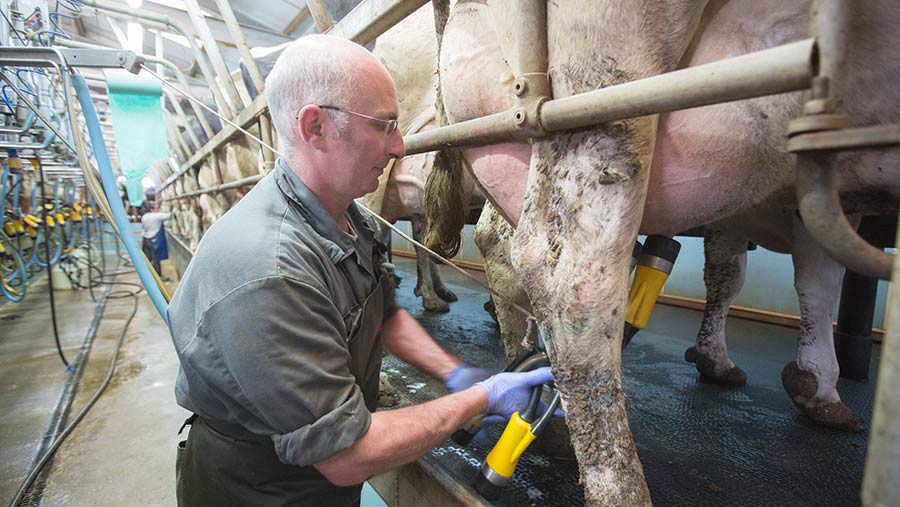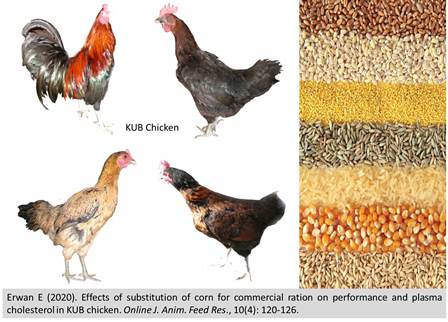Previous issue | Next issue | Archive
![]() Volume 10 (4); July 27, 2020 [Booklet] [EndNote XML for Agris]
Volume 10 (4); July 27, 2020 [Booklet] [EndNote XML for Agris]
The use of predicted apparent metabolizable energy values to understand the oil and fat variability in broilers
Thng A, Ting JX, Tay HR, Soh CY, Ong HC and Tey D.
Online J. Anim. Feed Res., 10(4): 150-157, 2020; pii: S222877012000021-10
DOI: https://dx.doi.org/10.51227/ojafr.2020.21
Abstract: The objective of this study was to analyze the predicted apparent metabolizable energy (AME) of different oil samples across Asia Pacific region and investigate the AME values in broilers of different ages (< 21 or > 21 days old). A total of 635 oil and fat samples consisting of 93 fish oils, 36 coconut oils, 70 crude palm oils, 42 refined palm oils, 43 soybean oils, 147 rice bran oils, 163 tallows and 41 lards were collected and analyzed over a span of eight years (2011 to 2018). The free fatty acid (FFA) content of oil and fat samples were analyzed through acid-base titration and the degree of saturation (ratio of unsaturation to saturated fatty acids; U:S) were determined with Gas Chromatography with Flame Ionization Detector (GC-FID). The FFA and U:S of the samples were then incorporated into the Wiseman equation to correlate the oil and fat qualities with the AME. Our survey revealed AME variations were prevalent in most of the oil types studied, with fish oils and tallows showing the largest energy gap within oil samples. The results showed that the predicted AME values for oil and fat samples differ across countries, even within batches from the same supplier. Taken together, our investigation suggests that there is a considerable variation in the AME values of oils and fats, which may affect the feed formulation precision.
Keywords: Dietary energy, Fatty acid composition, Lipids, Oil quality, Poultry
[Full text-PDF] [HTML] [Export from ePrint]
Review
Treatment trials of epizootic lymphangitis with local medicinal plants: a review
Asfaw M and Fentahun T
Online J. Anim. Feed Res., 10(4): 158-166, 2020; pii: S222877012000022-10
DOI: https://dx.doi.org/10.51227/ojafr.2020.22
Abstract: The aim of this paper was to review the use of local herbal medicines to treat Epizootic lymphangitis (EZL) and challenges related with safety, efficacy and quality control of herbal medicines. EZL has deleterious effect on both welfare and health of the horses and mules. In addition it has a serious negative impact on mainly the livelihoods of cart-horse owners/drivers. Basically, antifungal drugs for the treatment of EZL are costly and mostly unavailable in such areas especially in developing countries like Ethiopia. Medicinal herbs have a hopeful future since there are about half a million plants around the world, most of them have not yet been studied in medical practice, and current and future studies on medical activities can be effective in treating this disease. Furthermore, there is no gainsaying the fact that the requirements as well as the research protocols, standards and methods needed for the evaluation of the safety and efficacy of herbal medicines are much more complex than those required for conventional pharmaceuticals. These days, there are several trials on local plants like Xanthium stramorium (X. stramorium), Combretum molle (C. molle) seed and Phytolacca dodecandra (P. dodecandra) extracts inhibited the growth of Histoplasma capsulatum var farciminosum (H. capsulatum var farciminosum). Among these, the aqueous and n-butanol extracts of P. dodecandra with minimum inhibitory concentration (MIC) of (0.078%-0.156%) and (0.039%–0.078%) respectively have been inhibiting the growth of H. capsulatum var. farciminosum. In vivo, over 58.3% horses with the disease responded to treatment then the other two plant extracts. In conclusion, P. dodecandra extracts showed a significant effect to inhibit the growth of H. capsulatum var farciminosum in vitro and EZL in vivo.
Keywords: Combretum molle, Epizootic lymphangitis, Xanthium stramorium, Phytolacca dodecandra, Medicinal herbs.
[Full text-PDF] [HTML] [Export from ePrint]
Research Paper
Study of the flavonoids and secondary metabolites of the Argan tree (Argania spinose L.)
Hilali M, El Monfalouti H and Kartah BE.
Online J. Anim. Feed Res., 10(4): 167-171, 2020; pii: S222877012000023-10
DOI: https://dx.doi.org/10.51227/ojafr.2020.23
Abstract: The separation and identification of the main phenolic compounds present in the co-product of the Argan tree (Argania spinosa) were carried out using high performance liquid chromatography techniques coupled with mass spectrometry (LC-ESI-MS/MS).The study was based on the retention times of the peaks of the phenolic compounds in samples and was compared to those of the controls (reference compounds) and supplemented by an analysis of the fragmentations of the molecules by mass spectrometry. Phenolic compounds in the pulp of the Argan namely such as catechin (2.8%), epicatechin (14.7%), procyanidin (2.7%), quercetin (1.6%), luteolin (0.2%) and naringenin (0.07%) were found. Phenolic acid is consisted of gallic acid (5%) and protocatechuic acid (21.1%). These compounds are more dominant than flavonoids. The flavonoids-O-rhamnoglucosides the most dominant compounds is isorhoifoline (7.2%) and hesperidin (4.5%) against rutin (0.1%) and rhamnetin-O-rutinoside (0.5%) are less dominant. The main compounds are the hyperoside (13.4%) and isoquercetin (10%). On the other hand, naringenin-7-O-glucoside constituted the most minority compound of this type of flavonoid in the pulp of the fruit of the Argan tree (the percentage of naringenin-7-O-glucoside and quercetin-3-O-arabinose is 15.3%). There are other phenolic compounds in the pulp of the Argan namely such as catechin (2.8%), epicatechin (14.7%), procyanidin (2.7%), quercetin (1.6%), luteolin (0.2%) and naringenin (0.07%). The main flavonoids found in the leaves of the Argan tree are Quercetin (21.73%), Myricetin (54.34%), Hyperoside (8.69%), and also Myricetin-3-Ogalactoside (9.78%). Argan cake is rich in flavonoids. Among these, epicatechin (110 mg/kg), catechin (11 mg/kg), protocatechic acid (15.2 mg/kg), vanillic acid (16.3 mg/kg) and 4-hydroxybenzyl alcohol (8.6 mg/kg) are higher in Argan cake. Argan oil is richer in tocopherol (597 to 775 mg/kg), Argan oil is rich in gamma tocopherol (631 mg/kg), and that make Argan valuable nutraceutical. The study of the secondary metabolites and especially the flavonoids of the Argan tree was undertaken with the aim of identifying new metabolites making it possible to increase the industrial than commercial value of the Argan tree.
Keywords: Argan tree, Biological activity, Flavonoids, Metabolism, Phenolic acids.
[Full text-PDF] [HTML] [Export from ePrint]
Research Paper
Postmortem study on indigestible foreign bodies in rumen and reticulum of cattle (case: Haramaya and Awaday municipal abattoirs, Eastern Ethiopia)
Amin I and Fentahun T.
Online J. Anim. Feed Res., 10(4): 172-179, 2020; pii: S222877012000024-10
DOI: https://dx.doi.org/10.51227/ojafr.2020.24
Abstract: A cross-sectional study was conducted from November, 2017 to March, 2018 at Haramaya and Awaday Municipal Abattoirs of Oromia Regional State, Eastern Ethiopia, with the objectives of assessing the prevalence of rumen and reticulum foreign bodies, identifying types of foreign bodies and associated risk factors for the occurrences of foreign bodies. Following appropriate ante-mortum examinations, postmortem examinations were employed for the recovery of foreign body from rumen and reticulum. The study animals were selected by using systematic random sampling using regular interval to study animal from the total slaughtered animals. From a total of 384 (207 female and 177 male) cattle examined, 41.7% (n=160) were found to contain foreign bodies at slaughter. When the prevalence was compared between genders, breed, among different age groups, and different body condition score, higher prevalence of foreign bodies 50.7%, 75.0%, 80.0%, 83.3%, were observed in female, cross breed, age older than 10 years, and animal having poor body condition score respectively. These aforementioned factors are considered as potential risk factors were highly significantly associated with the occurrence of foreign bodies. Rumen harbored mostly plastic materials while reticulum was the major site for the retention of metallic objects. The non-penetrating foreign bodies have higher prevalence than penetrating foreign bodies. The commonly recovered non-penetrating foreign bodies were plastics (46.9%), cloth (30.0%), rope (21.3%) and leather (18.8%). The penetrating foreign bodies were metals (5%). Plastics were recovered as the most common foreign bodies and followed by cloths, Ropes, and leathers. It is concluded that the detection of this level of prevalence of foreign bodies in cattle causes high mortality and morbidity, reduced production and productivity. Therefore, appropriate solid waste disposal system need to implement in the study area to prevent health risk of ruminants and also to protect the environment.
Keywords: Body Condition Score, Cattle, Foreign body, Reticulum, Rumen.
[Full text-PDF] [HTML] [Export from ePrint]
Mini Review
Influence of dietary manipulations and milking frequency on production of dairy cows
Khaskheli AA.
Online J. Anim. Feed Res., 10(4): 180-184, 2020; pii: S222877012000025-10
DOI: https://dx.doi.org/10.51227/ojafr.2020.25
Abstract: Dairy cow responses to various types of diets differently and dairy farmers can use knowledge of its behavior to improve the cow well-being and yield. This review was carried out in order to better understanding the influence of dietary manipulation and milking frequency on the dairy cows’ production. The results obtained from review of already conducted studies revealed that the dairy cow is significantly affected by composition, quality, amount and regimes of the diet. Maximum daily milk production, milk protein, milk lactose, milk fat, total solids are recorded in dairy cows when ad-libitum feed and water is provided. Further, sufficient water intake is necessary for maintaining body fluids and proper ion balance, digestion, absorption, metabolization of nutrients, elimination and body cooling. Feeding and water frequency stimulate the mammary functions and milk synthesis, which is actually a non-invasive method. Reducing feeding frequency from 2x daily to 1x daily decreases milk yield from 7 to 38% in dairy cows, however changing feeding frequency from 2x to 3x daily results about 18% increase in milk production that can be economically acceptable. On the other hand, increasing milking frequency from 2x to 3x daily increase milk production up to 30%. Therefore, in addition of dietary manipulation and milking frequency, high quality feed and ad-libitum water plays always a key role for improving the performance and production of dairy cows.
Keywords: Ad-libitum, Diet, Performance, Production.
[Full text-PDF] [HTML] [Export from ePrint]
Research Paper
Effects of substitution of corn for commercial ration on performance and plasma cholesterol in KUB chicken
Erwan E.
Online J. Anim. Feed Res., 10(4): 185-190, 2020; pii: S222877012000026-10
DOI: https://dx.doi.org/10.51227/ojafr.2020.26
Abstract: The aim of the present study was to evaluate growth performance and plasma total cholesterol (TCHO) concentration of KUB chickens fed by substitution of commercial feed with corn in 1 of day-old chick of KUB were raised for 10 weeks in two dietary groups including only commercial feed (group A) and a commercial feed substituted by 30% corn (group B). Data were analysed by T-test. The results showed that there was no significant effect of the treatments on feed intake, body weight (BWG) and feed conversion ratio (FCR) in KUB chickens. Similarly, plasma TCHO concentration did not show any difference between two experimental rations. However, total income of commercial feed substituted with 30% corn was higher than commercial feed. It was concluded that corn could be used at 30% to substituted commercial feed without significantly affecting the KUB chicken performance and TCHO. Present research considered usefulness of corn as a potential alternative of commercial feeds in KUB chickens in Indonesia.
Keywords: KUB chickens, Feed Intake, Body Weight Gain, Feed Conversion Ratio, Commercial Feed, Corn
[Full text-PDF] [HTML] [Export from ePrint]
Previous issue | Next issue | Archive![]()
| < Prev | Next > |
|---|








